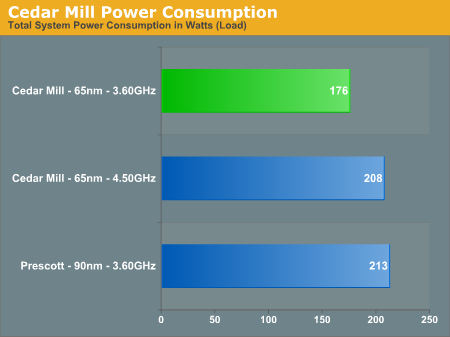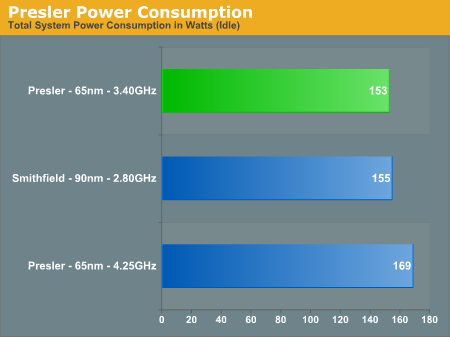Intel's 65nm Processors: Overclocking Preview
by Anand Lal Shimpi on October 25, 2005 12:05 AM EST- Posted in
- CPUs
Power Consumption of Intel's 65nm Processors
Other than poor performance, extremely high power consumption has been a frequently voiced criticism about Intel's Prescott. Thanks to its 31+ stage pipeline and high clock speeds, the Pentium 4 and Pentium D tend to draw quite a bit of power. How does 65nm change the power consumption landscape?
First up is Cedar Mill:
Next up, we loaded two threads of POV-ray's benchmark to fully load the CPUs and compare power consumption under load:
Next, we have Intel's dual core processors - Smithfield (90nm) and Presler (65nm):
Other than poor performance, extremely high power consumption has been a frequently voiced criticism about Intel's Prescott. Thanks to its 31+ stage pipeline and high clock speeds, the Pentium 4 and Pentium D tend to draw quite a bit of power. How does 65nm change the power consumption landscape?
First up is Cedar Mill:

Next up, we loaded two threads of POV-ray's benchmark to fully load the CPUs and compare power consumption under load:

Next, we have Intel's dual core processors - Smithfield (90nm) and Presler (65nm):












43 Comments
View All Comments
Viditor - Tuesday, October 25, 2005 - link
Fair enough...but certainly not with a Netburst chip. If I were AMD, I probably wouldn't release much info at this point either...
1. As this shows, there really isn't any competition until the end of 06.
2. Anouncing any concrete changes early risk creating an http://en.wikipedia.org/wiki/Osborne_effect">Osbourne effect.
3. Anticipation of the new Intel architecture is too far down the track to cut into current AMD sales.
While there certainly are a few hints at some of the things to come (which AT mentions http://www.anandtech.com/cpuchipsets/showdoc.aspx?...">here), there have been any number of stealth releases from AMD in the past (for example, nobody knew how much cooler the Rev E chips would end up being).
Sadly for us, we just can't predict what is going to happen at the end of next year...
How good will Conroe (et al) actually perform?
What will AMDs products actually be?
Doormat - Tuesday, October 25, 2005 - link
Yea, the chips still consume a whole lot of power, but 4.25GHz dual core is very competitive - and from some leaked roadmaps, AMD has the X2-5000 on tap for Q1'06 as well.I'm curious to know what the load temps were for those 4+GHz overclocks. And on the stock Intel HSF, right? I wonder what those crazy guys who use LN2 will get them too...
Kalessian - Tuesday, October 25, 2005 - link
Yawn, I overclocked my 1.8ghz Venice by 1gz a long time ago, and 1ghz on a K8 is much more powerful than 1ghz on a p4.You guys should have tested the lower end CPUs (2.8ghz or 3.2ghz) to test the limits. If those could push a 1500mhz+ increase I'd be impressed.
I bet I run cooler, too.
Not that progress is bad, mind you. I'm all for 65nm.